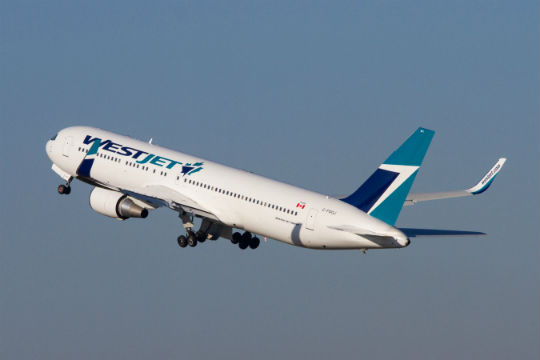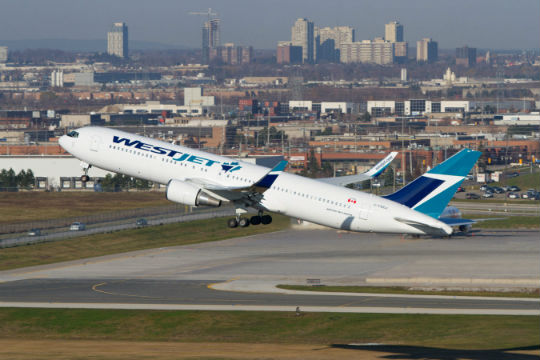Estimated reading time 6 minutes, 47 seconds.
Four 767s have been acquired from QANTAS, and are being equipped with Aviation Partners-Boeing winglets prior to entry into service.
On Jan. 10, 2016, WestJet celebrated the airline’s first flight on the seasonal route from Alberta to Hawaii using its own Boeing 767-300 extended-range aircraft.
The airline will operate two 767s from Calgary and Edmonton to Honolulu and Maui.
This is a huge step in WestJet’s growth, with the airline having just received Extended-range Twin-engine Operation (ETOPS) certification for long range transoceanic wide-body operations. It will fly its very own recently acquired and now ETOPS certified Boeing 767-300ER fleet on this route for the first time.
Previously, WestJet seasonally leased Boeing 757-200s from several airlines to carry out the Hawaiian route on its behalf, including North American Airlines and Thomas Cook.
WestJet 767 introduction
WestJet took delivery of its first Boeing 767-300 on Aug. 27, 2015, and its second in November. The airline is acquiring four ex-QANTAS 767s, equipping them with Aviation Partners Boeing winglets as well as a full new interior.
The inaugural domestic flight of the WestJet Boeing 767-300ER took place Oct. 22 from Toronto to Calgary. It was delivered to Calgary from Chennault International Airport, La. on Aug. 27 using its American registration.
The aircraft remained on the ground in Calgary for training and familiarization, prior to service entry.
The second WestJet 767 was delivered to Calgary on Nov. 20. WestJet has been flying its 767s between Calgary and Toronto since October in order to obtain ETOPS certification, building time and experience for crew, maintenance and operations staff.
Each WestJet 767-300ER can carry 262 passengers. The aircraft is equipped with a WestJet Plus cabin with 24 premium seats with 39 inch pitch in a two-by-two configuration. The main cabin has 238 seats with 31 inch pitch in a two-three-two configuration. One is equipped with WestJet Connect, the airline’s new inflight entertainment and wireless connectivity system, while the other will include tablets loaded with movies and popular television shows. By spring, all of the 767s will be equipped with WestJet Connect.
ETOPS certification
ETOPS certification allows twin engine aircraft to be operated for extended distances (usually over water), and is an involved process. ETOPS is concerned with flight times between diversion airfields, and is governed by the maximum flying time to a diversion while operating fully loaded on a single engine. ETOPS-120 and ETOPS-180 (120 and 180 minutes) are the most common standards. For type certification the airframe and engine must satisfy the basic ETOPS requirements and are subjected to tests such as shutting down an engine and flying the remaining engine during the complete diversion time.
It must be demonstrated during the diversion flight that the flight crew is not unduly burdened by extra workload due to the lost engine and that the probability of the remaining engine failing is extremely remote.
The airline must meet its own nation’s aviation regulator’s ETOPS operational requirements. ETOPS operational certification requires compliance with special engineering and flight crew procedures. Accordingly, pilots and engineering staff must be qualified and trained with a minimum number of flying hours.
Certification requires a series of ETOPS proving flights. Regulators monitor ETOPS performance of both type certificate holders and the airlines closely. Any technical incidents during an ETOPS flight must be recorded. The reliability of the particular airframe-engine combination is measured from the data collected and statistics published.
Unsatisfactory figures would lead to a downgrade, or suspension of ETOPS capabilities either for the type certificate holder or the airline.
The inaugural WestJet’s Boeing 767-300 ETOPS Hawaiian service departed from Calgary to Kahalui on Jan. 10, 2016.
ETOPS is required for WestJet’s direct service to Hawaii and for the commencement of the new Transatlantic routes to London Gatwick, which will start in May. By this time two more 767s will have joined the fleet, for a total of four aircraft.
Gatwick will be served from Vancouver, Edmonton, Calgary, Winnipeg, and Toronto by the 767s, and St. John’s, which will use 737s. As a contingency in case of ETOPS certification problems, WestJet had leased two 767s from Omni Air International.
The inaugural WestJet’s Boeing 767-300 ETOPS Hawaiian service departed from Calgary to Kahalui on Jan. 10, 2016.
The widebody ETOPS combination has been a huge step into the world of big jets for WestJet, a natural progression after having built a still growing fleet of over 112 Being 737 Next Generation narrowbodies, and two dozen Bombardier Q400 Turboprops.
If successful, the widebodies will likely soon be replaced by new build aircraft, which completely constitute the current Boeing 737 fleet.
“As we enter our 20th anniversary year, non-stop service from Alberta to Hawaii onboard our own wide-body aircraft is an exciting new chapter in the WestJet success story,” said Bob Cummings, WestJet executive vice president, Commercial.
“Albertans love non-stop WestJet service to Hawaii and we now have the opportunity to provide a full WestJet experience with our own Boeing 767-300 aircraft combined with our award-winning WestJetters.”



